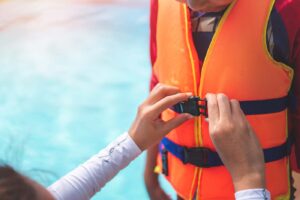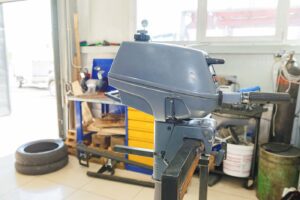Are you having trouble with your boat engine and don’t know where to start? Don’t worry; boat engine problems are one of the most common issues for boaters. With the right knowledge, however, understanding potential issues and troubleshooting them can be a breeze. In this blog post, we will provide an in-depth guide on how to recognize signs of difficulty with your boat engine as well as how to correctly diagnose and address these problems. We hope the information provided here arms you with the necessary skills for the successful maintenance of your vessel so that you can get back out on the water in no time!
Diagnosing Boat Engine Problems – Common Signs to Look For

When diagnosing boat engine problems, it is important to be aware of the common signs that may indicate a larger issue. One of the most obvious signs is smoke coming from the engine area. A visible white or blue smoke can indicate burning oil, while black smoke could signify an issue with air and fuel mixture. Additionally, if there is no smoke but there is an unusual odor coming from the engine compartment, this could also point to an underlying problem.
Other common signs include decreased performance, such as a decrease in power as well as excessive vibration and strange noises coming from the engine. It is also important to pay attention to any strange gauge readings, including high temperatures or pressures on gauges that usually stay within normal ranges. Ultimately, any time something seems abnormal with your boat’s engine it is best to take it in for a proper diagnosis and repair before putting it back into use.
Inspecting the Fuel System for Leaks and Damages
It is essential to inspect your boat’s fuel system for any signs of leaks or damages. Leaks in the fuel system can be hazardous and cause significant damage, so it is important to check for any visible signs of leaking fuel. If you notice any dripping or wet surfaces around the fuel system, it is best to investigate further. You should also look out for discoloration on any of the components, such as rust or other debris that could signify a leak.
Additionally, you should also assess the condition of all fuel lines and hoses to see if they are cracked or brittle and need replacing. Cracks in fuel lines can lead to leaks, so it is important to replace them immediately. If you find any leak points throughout your inspection process, make sure to repair them promptly with quality seals and materials designed specifically for marine use. Finally, always keep an eye out for dirt and debris build-up which can restrict flow through the engine and cause further issues.
Replacing Wear and Tear Parts as Necessary
Replacing worn or damaged parts of your boat engine is an important part of keeping it running well. This includes regularly inspecting the fuel system for any signs of leaks or damages and swapping out components such as hoses, fuel lines, spark plugs, and filters when needed. It is also important to replace belts periodically to ensure they have proper tension for optimal performance.
Other wear and tear parts that should be checked at least once a year include the water pump impeller, starter motor, alternator, and ignition system — all of which can cause serious damage if neglected. Additionally, other key components like the carburetor and exhaust system should be inspected regularly as well since these are essential for keeping your engine running smoothly. By investing in regular maintenance and replacing boat parts as necessary, you can ensure your boat engine is always functioning at its best!
Checking Electrical Connections and Battery Voltage
Checking the electrical connections and battery voltage of a boat is an important part of keeping any engine running properly. Electrical connections need to be examined for any corrosion or build-up, which can cause serious damage if left unchecked. Any loose connections should be tightened and any corroded wires should be cleaned and possibly replaced.
The starting battery should also be kept in good condition, which means regularly checking the voltage with a multimeter and charging the battery as needed. A fully charged 12V battery should read 12.40–12.70 volts. If it drops below 12, then you may want to consider replacing the battery. Keeping up with regular maintenance on your boat’s electrical system will ensure that your boat runs smoothly, giving you peace of mind while out on the water.
Troubleshooting Boat Cooling System Issues
Troubleshooting boat cooling system issues is a critical part of keeping your boat in tip-top shape. It is important to regularly inspect and maintain all components related to the cooling system, including the thermostat, water pump, hoses, clamps, and radiator. The thermostat helps regulate engine temperature by controlling the flow of coolant in the system; if it fails it can lead to an overheated engine.
Additionally, the water pump pumps coolant through the system which can also be malfunctioning if it is not working properly; furthermore, the hoses and clamps should be checked for any leaks or corrosion. Finally, inspecting the radiator for any blockages caused by debris or rust will ensure that air can pass through freely and help prevent overheating. If any of these components are not functioning correctly, they should be replaced or repaired as soon as possible to keep your engine running smoothly. Regular maintenance of all these parts should help prevent any major damage that could result from a breakdown in boat cooling systems.
Cleaning the Boat Engine of Dirt, Debris, and Buildup
Boats provide endless adventures on the sea or in the lake, but just like any other machine, their engines can become dirty, clogged, and worn. Regular maintenance is crucial to keep your boat engine running smoothly and prevent costly repairs. Cleaning the engine of dirt, debris, and buildup is an essential part of this maintenance routine. It requires patience, attention to detail, and the right tools and cleaning products.
Before beginning, make sure to disconnect the battery and allow the engine to cool down. Then, start removing the accumulated dirt and debris with a soft brush or compressed air. Next, use a degreaser and a clean cloth to remove any oily buildup or stains. Finally, rinse the engine thoroughly with a hose and let it dry before reconnecting the battery. Taking the time to clean your boat engine will not only improve its performance but also prolong its lifespan.
Taking these steps should help you identify and resolve most issues that come up while operating your boat engine. Diagnosing engine problems requires patience, attention to detail and experience. If your engine is exhibiting any of the mentioned signs of distress or damage, it’s best to seek a professional technician for advice and assistance. They can often spot the issue quicker and save you time and money in the long run. Whether you are an experienced boater, looking to become one, or a boat owner who needs extra guidance with engine maintenance; following the tips outlined in this article will keep your boat running smoothly. With these steps in hand, you can go faster, with fewer stops along the way.
Solving Boat Engine Problems with Mack Boring
Mack Boring is the go-to source for all of your boat engine needs. With over 100 years of experience in the boating industry, you can be sure that every component we offer is built to last. Our extensive selection includes diesel engines, electric motors, and gyro stabilizers that are designed to meet the rigorous demands of the boating industry. Plus, our knowledgeable staff is always on hand to answer any questions or concerns you may have about their products. Whether you’re looking for replacement parts or upgrading an existing boat engine, Mack Boring has everything you need to keep your vessel running smoothly and safely. To learn more, please visit our website and contact us today!





